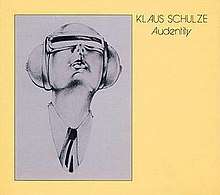Audentity
Audentity is the fifteenth album by Klaus Schulze. It was originally released in 1983, and in 2005 was the eleventh Schulze album reissued by Revisited Records. The reissue of Audentity is one of two examples of a Klaus Schulze reissue that changes the original order of the tracks (the other being Das Wagner Desaster Live).
| Audentity | ||||
|---|---|---|---|---|
 | ||||
| Studio album by | ||||
| Released | February 1983 | |||
| Recorded | 1982 | |||
| Genre | Electronic music, space music, trance music | |||
| Length | 96:09 (original) 154:19 (reissue) | |||
| Label | IC | |||
| Producer | Klaus Schulze | |||
| Klaus Schulze chronology | ||||
| ||||
| Review scores | |
|---|---|
| Source | Rating |
| Allmusic | |
Overview
As with Schulze's previous recording, Trancefer, Audentity is also heavily reliant on sequencers, but is less harsh in style. This is particularly evident in the tracks "Cellistica" and "Spielglocken". However, the heavy reliance on sequenced sound is not the case for all the tracks, and indeed "Sebastian im Traum" hints towards the operatic style of some of Schulze's much later works (like Totentag). "Sebastian im Traum", named after a poetry book of Georg Trakl, also contains a brief musical sequence that can be heard in the Michael Mann 1986 film Manhunter.
Track listing
All tracks composed by Klaus Schulze.
Disc 1
| No. | Title | Note | Length |
|---|---|---|---|
| 1. | "Cellistica" | on original release (disc 1, track 1) | 24:31 |
| 2. | "Spielglocken" | on original release (disc 2, track 1) | 21:24 |
| 3. | "Sebastian im Traum" | on original release (disc 2, track 2) | 28:21 |
Disc 2
| No. | Title | Note | Length |
|---|---|---|---|
| 1. | "Tango-Saty" | on original release (disc 1, track 2) | 5:47 |
| 2. | "Amourage" | on original release (disc 1, track 3) | 10:37 |
| 3. | "Opheylissem" | on original release (disc 1, track 4) | 5:11 |
| 4. | "Gem" | reissue bonus track | 58:10 |
Personnel
- Klaus Schulze – Computer and keys, program
- Rainer Bloss – Sounds, Glockenspiel
- Michael Shrieve – EEH Computer, Simmons percussion
- Wolfgang Tiepold – Cello